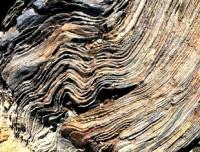You are here
Kimpersai pluto in Kazakhstan.

Geological excursions in Kazakhstan.
“The world is not the environment, but our only home in which we can only live! Humanity must learn to live in harmony with Nature, with its laws. People should not perceive themselves as gentlemen, but as part of Nature.”
N.N. Moses.
Geological sights in Kazakhstan.
Not all local residents living in the Khromtau district of the Aktobe region know that they live on a huge massif composed of olivine containing rocks (Olivin is a rock-forming mineral, magnesian-ferrous silicate with the formula (Mg, Fe) 2 [SiO4].
Forms a group or olivine series. The content of Fe and Mg varies between the two end members of the continuous isomorphic series of olivines: forsterite (Fo) - Mg2 [SiO4] and fayalite (Fa) - Fe2 [SiO4]. Olivine composes basic and ultrabasic igneous rocks and is very widespread in mantle.
This is one of the most common minerals wounded on Earth. A synonym is peridot (a word of French origin). A transparent yellow-green to green variety of olivine, which is a precious stone, is called chrysolite. Olivine was named in the descriptions of J. Vallerius in 1747.
In 1777, Balthazar Sazh (Balthazar Georges Sage) described olivine as chrysolite, now they call it prenite, while A. Werner used the term olivine to refer to green impregnations in basalts. Olivin is a typical high-temperature deep (melting point about 1400 -1900 ° C at normal pressure, depending on the composition) mineral.
It is common in many types of meteorites - pallasites, in mantle rocks, in igneous and high-temperature metamorphic and metasomatic rocks. The rock-forming mineral of ultrabasic igneous rocks - olivinites, dunites, etc.
In magmatic crystallization, earlier olivines and olivines of hyperbasites are richer (Fo) compared to later or olivines of the main and especially acidic rocks, the composition of which reaches almost pure (Fa) . Olivine is the most common mantle mineral to a depth of about 400 km, where a polymorphic transition occurs, with the conversion of olivine to major garnet.
When carried to the surface by lava - xenolith. On Earth, it is often found inside volcanic bombs, in the form of inclusions in basaltic lava and in iron-stone meteorites. When the volcano is destroyed by a sea surf, beaches of green olivine sand are sometimes formed.
Olivine is one of the main minerals of lunar regolith (along with pyroxene, anorthite and ilmenite). The olivine content in the soil sample delivered by the Hayabusa Japanese spacecraft from Itokawa asteroid is 39% (the most common mineral in the sample) and is called the Kimber-Sai Pluto.
The name “pluto” in the ancient Greeks meant “the god of the underworld”, and for geologists this term is applied to all magmatic manifestations frozen in depth. The Kimber-Say pluton has the shape of a mushroom with a flat hat, and the vertical magma-feeding channel serves as a leg.
The upper part of the pluton with an area of 1200 square meters. km exposed on the surface as a result of prolonged erosion. The city of Khromtau and more than a dozen villages and mines stand on pluto. The main feature of the pluton is its unusually high ore content: more than 20 large industrial deposits of chrome ores and more than 50 small chromite manifestations.
According to the reserves of chrome ores in the Kimpersai pluton, the republic takes the second place in the world after South Africa (Bushveld). Ores are mined by quarry and mine methods and exported to 60 countries.
In addition to chromites, pluton is also associated with numerous deposits of silicate cobalt-nickel ores, magnesite, refractory raw materials and ornamental stone. In recent years, pluto has turned into a lake region, several dozens of technogenic lakes are formed on the site of worked pits after they are flooded with groundwater.
Local residents have launched fish in these lakes and are now fishing.
Authority:
Candidate of Geological and Mineralogical Sciences, Associate Professor of KNTU Mikhail Kazantsev. The material was prepared by Victoria Kozina. “Newspaper AiF of Kazakhstan”, No. 3, 2013.
Photos
Alexander Petrov.







